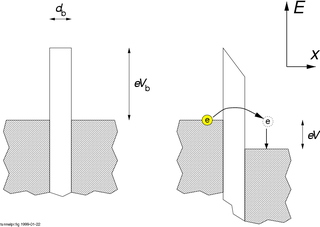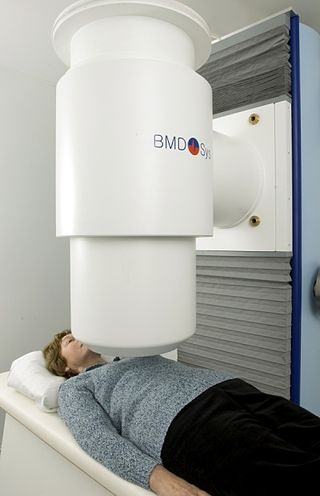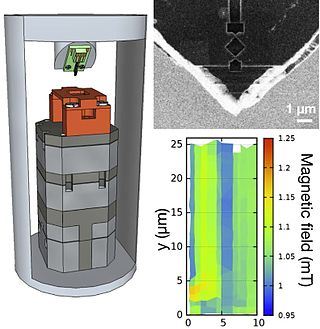
Superconductivity is a set of physical properties observed in certain materials where electrical resistance vanishes and magnetic fields are expelled from the material. Any material exhibiting these properties is a superconductor. Unlike an ordinary metallic conductor, whose resistance decreases gradually as its temperature is lowered, even down to near absolute zero, a superconductor has a characteristic critical temperature below which the resistance drops abruptly to zero. An electric current through a loop of superconducting wire can persist indefinitely with no power source.

A SQUID is a very sensitive magnetometer used to measure extremely weak magnetic fields, based on superconducting loops containing Josephson junctions.

A magnetometer is a device that measures magnetic field or magnetic dipole moment. Different types of magnetometers measure the direction, strength, or relative change of a magnetic field at a particular location. A compass is one such device, one that measures the direction of an ambient magnetic field, in this case, the Earth's magnetic field. Other magnetometers measure the magnetic dipole moment of a magnetic material such as a ferromagnet, for example by recording the effect of this magnetic dipole on the induced current in a coil.

Magnetoencephalography (MEG) is a functional neuroimaging technique for mapping brain activity by recording magnetic fields produced by electrical currents occurring naturally in the brain, using very sensitive magnetometers. Arrays of SQUIDs are currently the most common magnetometer, while the SERF magnetometer is being investigated for future machines. Applications of MEG include basic research into perceptual and cognitive brain processes, localizing regions affected by pathology before surgical removal, determining the function of various parts of the brain, and neurofeedback. This can be applied in a clinical setting to find locations of abnormalities as well as in an experimental setting to simply measure brain activity.
In electronics, cryoelectronics or cryolectronics is the study of superconductivity under cryogenic conditions and its applications. It is also described as the operation of power electronic devices at cryogenic temperatures. Practical applications of this field is quite broad, although it is particularly useful in areas where cryogenic environment exists such as superconducting technologies and spacecraft design. It also became a special branch of cryophysics and cryotechnics and plays a role in operations that require high resolution and precision measurements.

The Levitated Dipole Experiment (LDX) was an experiment investigating the generation of fusion power using the concept of a levitated dipole. The device was the first of its kind to test the levitated dipole concept and was funded by the US Department of Energy. The machine was also part of a collaboration between the MIT Plasma Science and Fusion Center and Columbia University, where another (non-levitated) dipole experiment, the Collisionless Terrella Experiment (CTX), was located.

In electrical engineering, electromagnetic shielding is the practice of reducing or redirecting the electromagnetic field (EMF) in a space with barriers made of conductive or magnetic materials. It is typically applied to enclosures, for isolating electrical devices from their surroundings, and to cables to isolate wires from the environment through which the cable runs. Electromagnetic shielding that blocks radio frequency (RF) electromagnetic radiation is also known as RF shielding.
Cryogenic particle detectors operate at very low temperature, typically only a few degrees above absolute zero. These sensors interact with an energetic elementary particle and deliver a signal that can be related to the type of particle and the nature of the interaction. While many types of particle detectors might be operated with improved performance at cryogenic temperatures, this term generally refers to types that take advantage of special effects or properties occurring only at low temperature.
Biomagnetism is the phenomenon of magnetic fields produced by living organisms; it is a subset of bioelectromagnetism. In contrast, organisms' use of magnetism in navigation is magnetoception and the study of the magnetic fields' effects on organisms is magnetobiology.
The cryogenic current comparator (CCC) is used in the electrical precision measurements to compare electric currents with the highest accuracy. This device exceeds the accuracy of other current comparators around several orders of magnitude. It is used in electrical metrology for exact comparative measurements of electric resistances or the amplification and measurement of extremely small electric currents.

In electronics, a tunnel junction is a barrier, such as a thin insulating layer or electric potential, between two electrically conducting materials. Electrons pass through the barrier by the process of quantum tunnelling. Classically, the electron has zero probability of passing through the barrier. However, according to quantum mechanics, the electron has a non-zero wave amplitude in the barrier, and hence it has some probability of passing through the barrier. Tunnel junctions serve a variety of different purposes.
David Cohen made many of the first pioneering measurements in the area of biomagnetism, although he was initially trained as a nuclear physicist.

Magnetic Field Imaging (MFI) is a non-invasive and side-effect-free cardiac diagnostic method. In more recent technology, magnetocardiography (MCG) has become the clinically predominant application for recording the heart's magnetic signals. that detects and records the electromagnetic signals that are associated with the heartbeat using a multi-channel magnetic sensor array. The electric signals are known from the ECG. In the 1990s and beyond, more recent technology has supplanted the MFI, particularly MCG (xref. Cardiomag Imaging, Inc.). Through clinical research in Europe, Asia, and the U.S. (see publications in footnotes), MCG has been proven to have practical application for diagnosis of cardiac disease, and has become the clinically predominant application for recording the heart's magnetic signals. In comparison to MCG, MFI, among others, records the whole relevant area above the chest of the person.

In condensed matter physics, scanning SQUID microscopy is a technique where a superconducting quantum interference device (SQUID) is used to image surface magnetic field strength with micrometre-scale resolution. A tiny SQUID is mounted onto a tip which is then rastered near the surface of the sample to be measured. As the SQUID is the most sensitive detector of magnetic fields available and can be constructed at submicrometre widths via lithography, the scanning SQUID microscope allows magnetic fields to be measured with unparalleled resolution and sensitivity. The first scanning SQUID microscope was built in 1992 by Black et al. Since then the technique has been used to confirm unconventional superconductivity in several high-temperature superconductors including YBCO and BSCCO compounds.
John Peter Wikswo, Jr. is a biological physicist at Vanderbilt University. He was born in Lynchburg, Virginia, United States.
In physics, persistent current is a perpetual electric current that does not require an external power source. Such a current is impossible in normal electrical devices, since all commonly-used conductors have a non-zero resistance, and this resistance would rapidly dissipate any such current as heat. However, in superconductors and some mesoscopic devices, persistent currents are possible and observed due to quantum effects. In resistive materials, persistent currents can appear in microscopic samples due to size effects. Persistent currents are widely used in the form of superconducting magnets.
The superconducting tunnel junction (STJ) — also known as a superconductor–insulator–superconductor tunnel junction (SIS) — is an electronic device consisting of two superconductors separated by a very thin layer of insulating material. Current passes through the junction via the process of quantum tunneling. The STJ is a type of Josephson junction, though not all the properties of the STJ are described by the Josephson effect.

Magnetomyography (MMG) is a technique for mapping muscle activity by recording magnetic fields produced by electrical currents occurring naturally in the muscles, using arrays of SQUIDs. It has a better capability than electromyography for detecting slow or direct currents. The magnitude of the MMG signal is in the scale of pico (10−12) to femto (10−15) Tesla (T). Miniaturizing MMG offers a prospect to modernize the bulky SQUID to wearable miniaturized magnetic sensors.
Jaakko A. Malmivuo is a Finnish engineer, academic, author, and opera singer. He was a professor of Bioelectromagnetism at Tampere University of Technology (TUT) from 1976 to 2010, an adjunct professor in the Faculty of Medicine at the University of Tampere as well as a visiting professor in the Faculty of Electrical Engineering and Computer Science, Electronics, and Medical Signal Processing at Technische Universität Berlin. Moreover, he was a director of the Ragnar Granit Institute at TUT from 1992.










